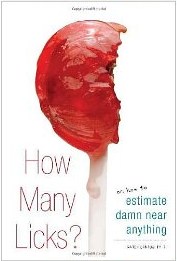 The idea of carrying out a Fermi estimate sounds like something that only nuclear physicists would be able to do with any degree of success, but a Fermi estimate, or Fermi problem, is nothing more than an approach to estimating numbers that cannot be counted. For instance, how many grains of sand on a beach? How many Jelly Beans in a bag? And, how many licks will it take to finish off that lollypop?
The idea of carrying out a Fermi estimate sounds like something that only nuclear physicists would be able to do with any degree of success, but a Fermi estimate, or Fermi problem, is nothing more than an approach to estimating numbers that cannot be counted. For instance, how many grains of sand on a beach? How many Jelly Beans in a bag? And, how many licks will it take to finish off that lollypop?
University of Michigan post-doctoral researcher Aaron Santos shows you how to “estimate damn near anything”. Every day we make simple estimations of all kinds of things, about time, distance, numbers, probabilities, Santos offers you the tools to make the most of the estimation skills most of us have the mental faculty to undertake.
Fermi problems? Nothing more than an informed estimate, an educated guess, a back-of-an-envelope calculation, a thumbnail sketch, a guesstimate. With these tools you could work out whether escaping from prison with nothing more than a spoon is possible, how big a book would a print out of the entire internet be, and even how many people are having an orgasm right now. Definitely a puzzle book with a difference and one that could prove useful in many ways. It’s on Amazon here.
Also on my desk at the moment:
Curious Folks Ask – Sherry Seethaler – 162 real answers to quesstions about amazing inventions, fascinating products, and medical mysteries, such as why is glue sticky? Is one horsepower really equal to the power of a lone horse? Why does the flu change every year?
The Immortal Life of Henrietta Lacks – Rebecca Skloot – As good as any detective novel this book highlights the complexities of scientific research whilst showing the human side. The historical background is fascinating and shows how the ethical approach to research has improved. It continues the debate on whether we should give up tissue to forward scientific research freely or whether we should be rewarded. [Review by PAB]
Second Nature – The Inner Lives of Animals, by Jonathan Balcombe who explains that despite centuries, if not millennia of self-centred humanity, people are not the only animals that matter.
The Ape of Sorrows – From stranger to destroyer, the inside story of humans by Maurice Rowden. If Balcombe argues that the inner lives of other animals make them our equals, then it is the inner turmoil we call the human condition that does still set us apart from other species and that our having lost our original habitat thousands of years ago has left us tragically committed to our own destruction. Nevertheless, Rowden offers humanity an escape if only we could stop piling on our sorrows and settle into the habitat in which we find our species today.
Shrimp – The endless quest for pink gold by Jack and Anne Rudloe is an unusual book to say the least, focusing as it does on an important but often ignored human food source. As a Brit, it is always incongruous to see the word shrimp juxtaposed with what so obviously is a prawn. But, hey that’s transatlantic translation for you. Shrimp is essentially about prawns, the people who love to eat them, the fisherman who catch them and the aquaculturists who raise them in unimaginable numbers. Actually, those numbers are not quite unimaginable, just figure out a Fermi estimate and you could get an idea.
Finally, Breathrough by Jon Queijo describes the ten greatest discoveries in medicine that have saved millions of lives and changed the way we view our world. From vaccines and X-rays to DNA and antibiotics, the petty bickering, the dumb luck, the humour…and the science.